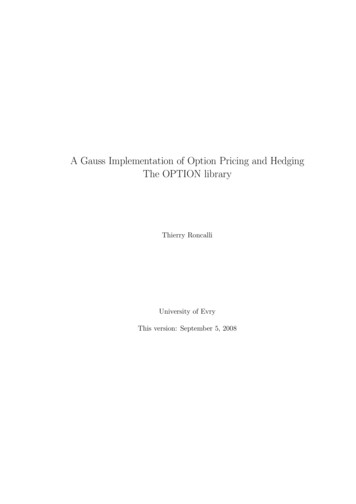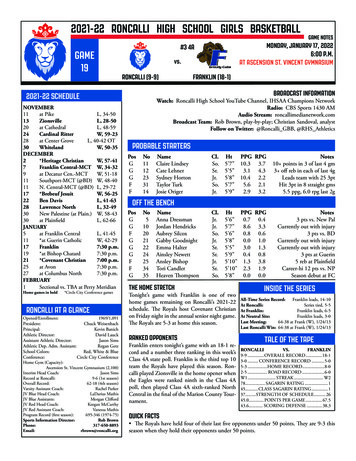
Transcription
A Gauss Implementation of Option Pricing and HedgingThe OPTION libraryThierry RoncalliUniversity of EvryThis version: September 5, 2008
Contents1 Introduction1.1 Installation . . . . . .1.2 Getting started . . . .1.2.1 readme.txt file1.2.2 Setup . . . . .1.3 What is OPTION ? .1.4 Using Online Help . .333335102 Option Pricing and Hedging2.1 Notations . . . . . . . . . . . . . . . . . . . . . . . . . . . . . . . . . . . . . . . . .2.2 The Black and Scholes [1973] model . . . . . . . . . . . . . . . . . . . . . . . .2.2.1 The general framework . . . . . . . . . . . . . . . . . . . . . . . . . . . . . .2.2.2 European option . . . . . . . . . . . . . . . . . . . . . . . . . . . . . . . . .2.2.3 American option . . . . . . . . . . . . . . . . . . . . . . . . . . . . . . . . .2.2.4 Barrier and double barrier options . . . . . . . . . . . . . . . . . . . . . . .2.2.5 Greeks computing . . . . . . . . . . . . . . . . . . . . . . . . . . . . . . . .2.2.6 Volatility smile . . . . . . . . . . . . . . . . . . . . . . . . . . . . . . . . . .2.2.7 Binary and Corridor options . . . . . . . . . . . . . . . . . . . . . . . . . .2.3 The Cox, Ross and Rubinstein [1981] model . . . . . . . . . . . . . . . . . . . .2.4 Pricing models with volatity smile . . . . . . . . . . . . . . . . . . . . . . . . . . .2.4.1 The Merton [1976] jump diffusion model . . . . . . . . . . . . . . . . . . .2.4.2 The Heston [1993] stochastic volatility model . . . . . . . . . . . . . . . .2.4.3 The Chang, Chang and Lim [1998] subordinated process model . . . . . .2.5 Calibrated pricing models . . . . . . . . . . . . . . . . . . . . . . . . . . . . . . . .2.5.1 The Breeden and Litzenberger [1978] model . . . . . . . . . . . . . . .2.5.2 The Dupire [1994] local volatility model . . . . . . . . . . . . . . . . . . .2.5.3 The SABR [2002] model . . . . . . . . . . . . . . . . . . . . . . . . . . . . .2.5.4 The Durrleman [2004] model . . . . . . . . . . . . . . . . . . . . . . . . .2.5.5 The PDM model . . . . . . . . . . . . . . . . . . . . . . . . . . . . . . . . .2.6 Numerical methods . . . . . . . . . . . . . . . . . . . . . . . . . . . . . . . . . . . .2.6.1 Solving PDE with numerical methods . . . . . . . . . . . . . . . . . . . . .2.6.1.1 The finite difference method . . . . . . . . . . . . . . . . . . . . .2.6.1.2 The different numerical algorithms . . . . . . . . . . . . . . . . . .2.6.1.3 Integrating the boundary conditions . . . . . . . . . . . . . . . . .2.6.1.4 Stability of the numerical algortihms . . . . . . . . . . . . . . . .2.6.1.5 The Gauss implementation . . . . . . . . . . . . . . . . . . . . . .2.6.1.6 Link between Backward PDE and Forward PDE in option pricing2.6.2 Numerical integration . . . . . . . . . . . . . . . . . . . . . . . . . . . . . 63839394143.
12.6.3Monte Carlo and quasi-Monte Carlo methods2.6.3.1 The Black and Scholes model . . . .2.6.3.2 Other diffusion processes . . . . . .2.6.3.3 Reduction variance techniques based2.6.3.4 Simulating binomial trees . . . . . . . . .on. . . . . . . . . . . . . . . . . . . . . . . . . . . . . . . .antithetic variables. . . . . . . . . . .3 Some examples3.1 Pricing vanilla options with closed-form formulas . . . . . . . . . .3.1.1 Black-Scholes examples . . . . . . . . . . . . . . . . . . . .3.1.2 Cox-Ross-Rubinstein examples . . . . . . . . . . . . . . . .3.1.3 American options . . . . . . . . . . . . . . . . . . . . . . . .3.2 Implied volatilities, volatility skew and volatility smile . . . . . . .3.2.1 Computing the smile . . . . . . . . . . . . . . . . . . . . . .3.2.2 Smile in the Heston model . . . . . . . . . . . . . . . . . . .3.2.3 Computing the skew . . . . . . . . . . . . . . . . . . . . . .3.2.4 An example with binary options . . . . . . . . . . . . . . .3.3 Computing risk-neutral probability density function . . . . . . . .3.3.1 The breeden-Litzenberger method . . . . . . . . . . . . . .3.3.2 Computing the density function in the Heston model usingapproximation . . . . . . . . . . . . . . . . . . . . . . . . .3.3.3 The pdf in the SABR model . . . . . . . . . . . . . . . . .3.4 Calibrating the parameters . . . . . . . . . . . . . . . . . . . . . .3.4.1 The Durrleman model . . . . . . . . . . . . . . . . . . . . .3.4.2 The PDM model . . . . . . . . . . . . . . . . . . . . . . . .3.4.2.1 The case of three volatilities . . . . . . . . . . . .3.4.2.2 Taking into account the skew . . . . . . . . . . . .3.5 The Dupire and the SABR models . . . . . . . . . . . . . . . . . .3.5.1 Computing the local volatility surface . . . . . . . . . . . .3.5.2 Pricing with the local volatility model . . . . . . . . . . . .3.5.2.1 With the Backward PDE solver . . . . . . . . . .3.5.2.2 With the MC solver . . . . . . . . . . . . . . . . .3.5.3 Understanding the SABR dynamics . . . . . . . . . . . . .3.5.3.1 With respect to the β parameter . . . . . . . . . .3.5.3.2 With respect to the ATM implied volatility . . . .3.6 Solving PDE . . . . . . . . . . . . . . . . . . . . . . . . . . . . . .3.6.1 The influence of the θ scheme . . . . . . . . . . . . . . . .3.6.2 Pricing an American option . . . . . . . . . . . . . . . . . .3.6.3 Comparing forward and backward PDE . . . . . . . . . . .3.7 Monte-Carlo methods . . . . . . . . . . . . . . . . . . . . . . . . .3.7.1 Studying the MC convergence in the case of the BS model .3.7.2 Computing the price of Look-back options . . . . . . . . . .3.7.3 An example of average of Best-Of in time across assets . . .3.7.4 Example with options on multi-assets . . . . . . . . . . . .3.7.5 Simulating binomial trees . . . . . . . . . . . . . . . . . . .Bibliography. . . . . . . . . . . . . . . . . . . . . . . . . . . . . . . . . . . . . . . . . . . . . . . . . . . . . . . . . . . . . . . . . . . . . . . . . . . . . . . . . . . . . . . . .the Durrleman. . . . . . . . . . . . . . . . . . . . . . . . . . . . . . . . . . . . . . . . . . . . . . . . . . . . . . . . . . . . . . . . . . . . . . . . . . . . . . . . . . . . . . . . . . . . . . . . . . . . . . . . . . . . . . . . . . . . . . . . . . . . . . . . . . . . . . . . . . . . . . . . . . . . . . . . . . . . . . . . . . . . . . . . . . . . . . . . . . . . . . . . . . . . . . . . . . . . . . . . 1717272747676777979818487878889919195
2
Chapter 1Introduction1.1Installation1. The file option.zip is a zipped archive file. Copy this file under the root directory of Gauss,for example D:\GAUSS60.2. Unzip the file. Directories will then be created and files will be copied over h\srcreadme.txtDLLslibrary fileexample and tutorial filessource code filessource code files3. If your root of Gauss is D:\GAUSS60, the installation is finished, otherwise you have tomodify the paths of the library using notepad or the LibTool. Another way to update thelibrary is to run Gauss, log on to the option\src directory, delete the path with thecommand lib option -n and add the path to the library with the command lib option -a.1.2Getting startedGauss 6.0.57 for Windows is required to use the OPTION routines.1.2.1readme.txt fileThe file readme.txt contains last minute information on the OPTION procedures. Please read itbefore using them.1.2.2SetupIn order to use these procedures, the OPTION library must be active. This is done by includingOPTION in the LIBRARY statement at the top of your program:library option;3
4CHAPTER 1. INTRODUCTIONTo reset global variables in subsequent executions of the program and in order to load DLLs, thefollowing instruction should be used:optionSet;
1.3. WHAT IS OPTION ?1.35What is OPTION ?OPTION is a Gauss library for option pricing and hedging. It includes several models andconcerns different option types.OPTION contains the procedures whose list is given below. Black and Scholes model– AmericanBS– AmericanBS Delta– AmericanBS Gamma– AmericanBS ImpVol– AmericanBS Omega– AmericanBS Theta– AmericanBS Vega– BinaryBS– BinaryBS Delta– BinaryBS Gamma– BinaryBS Vega– CorridorBS– EuropeanBS– EuropeanBS Delta– EuropeanBS Gamma– EuropeanBS impVol– EuropeanBS Omega– EuropeanBS Theta– EuropeanBS Vega– EuropeanPayOff Black and Scholes smiled model– BinarySmiled– BinarySmiled Delta– BinarySmiled Gamma– BinarySmiled Vega– CorridorSmiled Merton/Bates model– AmericanMerton– AmericanMerton Delta
6CHAPTER 1. INTRODUCTION– EuropeanMerton– EuropeanMerton Delta Rubinstein and Reiner model of Barrier options– EuropeanBS DIC– EuropeanBS DIP– EuropeanBS DOC– EuropeanBS DOP– EuropeanBS UIC– EuropeanBS UIP– EuropeanBS UOC– EuropeanBS UOP– EuropeanBS KIC– EuropeanBS KIP– EuropeanBS KOC– EuropeanBS KOP Cox, Ross and Rubinstein model– AmericanCRR– AmericanCRR Delta– AmericanCRR Gamma– AmericanCRR impVol– AmericanCRR Omega– AmericanCRR Theta– AmericanCRR Vega– AsianFixedStrikeCRR– AsianFixedStrikeCRR Delta– AsianFixedStrikeCRR Gamma– AsianFixedStrikeCRR impVol– AsianFixedStrikeCRR Omega– AsianFixedStrikeCRR Theta– AsianFixedStrikeCRR Vega– AsianFloatingStrikeCRR– AsianFloatingStrikeCRR Delta– AsianFloatingStrikeCRR Gamma– AsianFloatingStrikeCRR impVol– AsianFloatingStrikeCRR Omega– AsianFloatingStrikeCRR Theta
1.3. WHAT IS OPTION ?– AsianFloatingStrikeCRR Vega– EuropeanCRR– EuropeanCRR Delta– EuropeanCRR Gamma– EuropeanCRR impVol– EuropeanCRR Omega– EuropeanCRR Theta– EuropeanCRR Vega– KnockInDownCRR– KnockInDownCRR Delta– KnockInDownCRR Gamma– KnockInDownCRR impVol– KnockInDownCRR Omega– KnockInDownCRR Theta– KnockInDownCRR Vega– KnockInUpCRR– KnockInUpCRR Delta– KnockInUpCRR Gamma– KnockInUpCRR impVol– KnockInUpCRR Omega– KnockInUpCRR Theta– KnockInUpCRR Vega– KnockOutDownCRR– KnockOutDownCRR Delta– KnockOutDownCRR Gamma– KnockOutDownCRR impVol– KnockOutDownCRR Omega– KnockOutDownCRR Theta– KnockOutDownCRR Vega– KnockOutUpCRR– KnockOutUpCRR Delta– KnockOutUpCRR Gamma– KnockOutUpCRR impVol– KnockOutUpCRR Omega– KnockOutUpCRR Theta– KnockOutUpCRR Vega– LookBackCRR7
8CHAPTER 1. INTRODUCTION– LookBackCRR Delta– LookBackCRR Gamma– LookBackCRR impVol– LookBackCRR Omega– LookBackCRR Theta– LookBackCRR Vega– PlotTree– PrintTree– Simulate CRR Heston model– BinaryHeston– CorridorHeston– EuropeanHeston– EuropeanHeston ImpVol– EuropeanHeston Skew Chang, Chang and Lim model– AmericanCCL– EuropeanCCL Dupire local volatility model– ImpVol to LocalVol– LocalVol Backward PDE Solve– LocalVol Init– LocalVol Forward PDE Solve– LocalVol Simulate SDE Breeden and Litzenberger model to compute density from smile– EuropeanBS Density– Smile to Density– SplineSmile to Density SABR model– ImpVol LN 2 Normal– ImpVol Normal 2 LN– SABR ATM– SABR Calibrate
1.3. WHAT IS OPTION ?– SABR Calibrate ATM– SABR Delta– SABR ImpVol– SABR ImpVol Black– SABR ImpVol Black 2– SABR ImpVol Normal– SABR ImpVol Normal 2– SABR ImpVol ATM– SABR PDF– SABR Vega Durrleman model– VD Calibration– VD HestonDensity– VD HestonSmile– VD Smile– VD Smile to Density PDM model– PDM Calibrate– PDM ImpVol– PDM Skew– PDM Skew2ImpVol Yield curve models– BDFS– CIR– LongstaffSchwartz– Vasicek Procedures for simulating diffusion processes– array3d get x– array3d get y– array3d get z– LocalVol Simulate SDE– mGBM getDate– mGBM getSimul– mGBM getAsset– qmc Simulate GBM9
10CHAPTER 1. �––––qmc Simulate GBM avqmc Simulate JDFqmc Simulate JDF avqmc Simulate mSDEqmc Simulate mSDE avqmc Simulate OUqmc Simulate OU avqmc Simulate SDEqmc Simulate SDE avqmc Simulate SDE milsteinqmc Simulate SDE2qmc Simulate SDE2 avrndSetSimulate CRRsimulate GBMsimulate GBM2simulate mGBM Procedures for solving PDE–––––PartialBarrier PDEPDEPDE GetMeshPDE ReadFilePDE Solve Procedures for computing numerical adLegendre1quadLegendre2quadLegendre3Simpson1Using Online HelpOPTION library supports Windows Online Help. Before using the browser, you have to verifythat the OPTION library is activated by the library command.
Chapter 2Option Pricing and Hedging2.1NotationsWe denote by S (t) the price of the asset. S (0) or S0 is the initial price or the current price.Generally, we use a geometric brownian motion for the dynamics of the asset price:½dS (t) µS (t) dt σS (t) dW (t)S (t0 ) S0σ is called the volatility. We notice r the instantaneous interest rate.Let K be the strike of an European option. The payout of a call option is (S (T ) K) whereasit is (K S (T )) for a put option. T is the settlement date of the option. We define τ T tas the residual maturity.2.22.2.1The Black and Scholes [1973] modelThe general frameworkLet C (t, S (t)) be the price of a call option of maturity τ (or settlemant date T ) and strike K.Let (Ω, F, P) be the probability space. We assume that the price S (t) of the underlying asset is adiffusion process with the following SDE representation:½dS (t) µS (t) dt σS (t) dW (t)S (t0 ) S0We may show that the fundamental pricing equation take the form:½ 1 2 22 σ S CSS (µ λσ) CS Ct rC 0C (T, S) (S K) The function λ is interpreted as the risk price of the Wiener process W (t). For an asset with acost-of-carry equal to b, we may show that:λ µ bσ11
12CHAPTER 2. OPTION PRICING AND HEDGINGTo obtain the solution, we may apply the Girsanov theorem with φ (t) λ. We denote by Q thenew probability distribution. We have:½dS (t) S (t0 ) bS (t) dt σS (t) dW Q (t)S0with W Q (t) a brownian motion under the probability Q. We may then apply the Feynman-Kactheorem to obtain the martingale solution:C (t0 , S0 ) exp [ r (T t0 )] · E Q [ max (0, S (T ) K) Ft0 ]2.2.2European optionThe price of an European option is given by the following formulas:BSCEUBSPEU S0 e(b r)τ Φ (d1 ) Ke rτ Φ (d2 ) S0 e(b r)τ Φ ( d1 ) Ke rτ Φ ( d2 )withd1 d2 µ µ ¶¶S01 ln bτ σ τK2σ τ d1 σ τ1 The syntax of the corresponding procedure EuropeanBS isC/P EuropeanBS(S0,K,tau,sigma,b,r);The online help is the following:/*** EuropeanBS**** Purpose: Premimum of an European option (Black and Scholes [1973]).**** Format: C/P EuropeanBS(S0,K,sigma,tau,b,r);**** Input:S0 - matrix E*E, underlying prices S0**K - matrix E*E, Strike prices K**sigma - matrix E*E, volatility sigma**tau - matrix E*E, maturity tau**b - matrix E*E, cost-of-carry b**r - matrix E*E, interest rate r**** Output:C/P - matrix E*E, Option premium**** Globals: option type - string**"call" for a call option (default)**"put" for a put option**** Remarks:***/
2.2. THE BLACK AND SCHOLES [1973] MODEL2.2.313American optionThe price of the American option is computed using the quadratic approximation of BaroneAdesi and Whaley [1987]. Let M , N and L be three scalars:M 2r/ σ 2NL 2b/ σ 21 exp ( rτ )For the call option, we have1½BSCAM withBSCEU(S0 ) A1S0 K¡ S0 q1S?if S0 S ?if S0 S ?hi S?A1 1 e(b r)τ Φ (d1 (S ? ))q1and1q1 2ÃrM(N 1) 4L!2 (N 1) We obtain the value S ? by solving the following non-linear equation:hi S?BS(S ? ) 1 e(b r)τ Φ (d1 (S ? ))S ? K CEUq1For the put option, we have½BSPAM withBSPEU(S0 ) A2K S0¡ S0 q2S?if S0 S ?if S0 6 S ?hi S?A2 1 e(b r)τ Φ ( d1 (S ? ))q2and1q2 2Ã (N 1) rM(N 1) 4L!2We obtain the value S ? by solving the following non-linear equation:hi S?BSK S ? PEU(S ? ) 1 e(b r)τ Φ ( d1 (S ? ))q2Remark 1 The non-linear equations are solved by a bi-section algorithm.The syntax of the corresponding procedure AmericanBS isC/P AmericanBS(S0,K,tau,sigma,b,r);The online help is the following:1 Ifb r, the price of the American call option is equal to the price of the European call option.
14CHAPTER 2. OPTION PRICING AND HEDGING/*** AmericannBS**** Purpose: Premimum of an American option (Black and Scholes [1973]).**** Format: C/P AmericanBS(S0,K,sigma,tau,b,r);**** Input:S0 - matrix E*E, underlying prices S0**K - matrix E*E, Strike prices K**sigma - matrix E*E, volatility sigma**tau - matrix E*E, maturity tau**b - matrix E*E, cost-of-carry b**r - matrix E*E, interest rate r**** Output:C/P - matrix E*E, Option premium**** Globals: option type - string**"call" for a call option (default)**"put" for a put option**** Remarks:***/2.2.4Barrier and double barrier optionsWe use the formulas obtained by Rubinstein and Reiner [1991] for the pricing of Barrier options.For the Down & In call DIC option, we haveC/P EuropeanBS DIC(S0,K,sigma,tau,b,r,tau D,L,R);We use the same syntax for Down & In put DIP (EuropeanBS DIP), Down & Out callDOC (EuropeanBS DOC), Down & Out put DOP (EuropeanBS DOP), Up & In Call UIC(EuropeanBS UIC), Up & In put UIP (EuropeanBS UIP), Up & Out call UOC (EuropeanBS UOC)and Up & Out put UOP (EuropeanBS UOP). The parameters S0, K, sigma, tau, b and r arethe same parameters used in the EuropeanBS procedure. However, you remark three additionalparameters : τ D is the settlement maturity (whereas τ is the residual strike maturity), L is thebarrier level and R is the rebate.For double barriers, we haveC/P EuropeanBS KIC(S0,K,sigma,tau,b,r,tau D,L,H);L and H are the lower and upper barrier and there is no rebate. We use the same syntax forKnock-In put KIP (EuropeanBS KIP), Knock-Out call KOC (EuropeanBS KOC) and Knock-OutPut (EuropeanBS KOP).2.2.5Greeks computingWe have introduced some procedures to compute the hedging coefficients. For the Black andScholes model, we have :DeltaG EuropeanBS Delta(S0, K, sigma, tau, b, r); EuropeanBS Gamma(S0, K, sigma, tau, b, r);OmegaTheta EuropeanBS Omega(S0, K, sigma, tau, b, r); EuropeanBS Theta(S0, K, sigma, tau, b, r); EuropeanBS Vega(S0, K, sigma, tau, b, r);Vega
2.2. THE BLACK AND SCHOLES [1973] MODEL15Remark that we don’t have implemented the greeks for all the model. However, it is very easyto compute them numerically using the procedures Option gradp and Option hessp. Let usconsider an example with the LookBackCRR procedure. The first thing to do is to create a genericprocedure with only one argument which may be S0 (for the Delta and Gamma coefficients), τ(for the Theta coefficient) and σ (for the Vega coefficient).proc (1) LookBackCRR(XXX);local S0,sigma,tau,b,r,N,CallPut;S0 option S0;sigma option sigma;tau option tau;b option b;r option r;N option N;if option greeks 1;CallPut LookBackCRR(XXX,sigma,tau,b,r,N);elseif option greeks 2;elseif option greeks 3;CallPut LookBackCRR(S0,XXX,tau,b,r,N);elseif option greeks 4;CallPut LookBackCRR(S0,sigma,XXX,b,r,N);elseif option greeks 5;CallPut LookBackCRR(S0,sigma,tau,XXX,r,N);elseif option greeks 6;CallPut ut);endp;For the Delta coefficient, we have also:proc (1) LookBackCRR Delta(S0,sigma,tau,b,r,N);local Delta,XXX;option S0 S0; option sigma sigma; option tau tau;option b b; option r r; option N N;option greeks 1;XXX S0;Delta Option gradp(& LookBackCRR,XXX);retp(Delta);endp;For the Gamma coefficient, we have:proc (1) LookBackCRR Gamma(S0,sigma,tau,b,r,N);local Gamma ,XXX;option S0 S0; option sigma sigma; option tau tau;option b b; option r r; option N N;option greeks 1;XXX S0;Gamma Option hessp(& LookBackCRR,XXX);retp(Gamma );endp;
16CHAPTER 2. OPTION PRICING AND HEDGINGThe only difference is that we use the Option hessp procedure instead of Option gradp procedure. For the Theta coefficient, we have:proc (1) LookBackCRR Theta(S0,sigma,tau,b,r,N);local Theta,XXX;option S0 S0; option sigma sigma; option tau tau;option b b; option r r; option N N;option greeks 4;XXX tau;Theta Option gradp(& LookBackCRR,XXX);retp(Theta);endp;For the Vega coefficient, we have:proc (1) LookBackCRR Vega(S0,sigma,tau,b,r,N);local Vega,XXX;option S0 S0; option sigma sigma; option tau tau;option b b; option r r; option N N;option greeks 3;XXX sigma;Vega Option gradp(& LookBackCRR,XXX);retp(Vega);endp;Finally, the implementation of the Omega coefficient is the following:proc (1) LookBackCRR Omega(S0,sigma,tau,b,r,N);local Omega;Omega S0 .* LookBackCRR Delta(S0,sigma,tau,b,r,N) ;2.2.6Volatility smileTo obtain the implied volatility from option market prices, we use the EuropeanBS ImpVol procedure.2.2.7Binary and Corridor optionsLet S (t) be the stock price at time t. Following Rubinstein and Reiner [1991], the pay-off ofthe cash-or-nothing digital option is:G (S) 1[S K]for a call option of strike K. The price at time t0 of the digital option with a date of maturity Tis also given by the following formula:"#Z TBC (t0 , S (t0 )) E 1[S(T ) K] expr (t) dt Ft0t0
2.2. THE BLACK AND SCHOLES [1973] MODEL17with Ft the associated filtration of the risk neutral probability measure Q and r (t) the risklessinterest rate. In the case of the BS model, we obtain:BC (t0 , S (t0 )) e rτ Φ (d2 )withd2 d1 d1 σ τln SK0 bτ1 σ τ2σ τThe online help of the BinaryBS is the following:/*** BinaryBS**** Purpose: Pricing of Digital options (Black and Scholes [1973]).**** Format: C/P BinaryBS(S0,K,sigma,tau,b,r);**** Input:S0 - matrix E*E, underlying prices S0**K - matrix E*E, Strike prices K**sigma - matrix E*E, volatility sigma**tau - matrix E*E, maturity tau**b - matrix E*E, cost-of-carry b**r - matrix E*E, interest rate r**** Output:C/P - matrix E*E, Option premium**** Globals: option type - string**"call" for a call option (default)**"put" for a put option**** Remarks:***/In the case of volatility smile, we have the following formula:BCsm (t0 , S (t0 )) BC (t0 , S (t0 )) pυ (t0 , S (t0 ))with υ (t0 , S (t0 )) the Vega of the vanilla option C (t0 , S (t0 )) and p the skew parameter:p Σ (T, K) KThe online help of the BinaryBS is the following:/*** BinarySmiled**** Purpose: Pricing of Digital options (Smiled model with Vega correction).**** Format: C/P BinarySmiled(S0,K,sigma,tau,b,r,p);**** Input:S0 - matrix E*E, underlying prices S0**K - matrix E*E, Strike prices K**sigma - matrix E*E, volatility sigma**tau - matrix E*E, maturity tau
18CHAPTER 2. OPTION PRICING AND HEDGING********** Output:**** Globals:******** Remarks:***/b - matrix E*E, cost-of-carry br - matrix E*E, interest rate rp - matrix E*E, parameter p of the skew d(ImpVol)/d(K)C/P - matrix E*E, Option premiumoption type - string"call" for a call option (default)"put" for a put optionWe define the corridor option as a serie of double binaries options. The pay-off isG (S (T )) NX1[S(ti ) [L,H]]i 1where (ti )1 i N are the fixing dates. We may prices the corridor using the formulaCC (t0 , S (t0 )) e rτNX[% (S0 , L, σ, τ i , b, r) % (S0 , H, σ, τ i , b, r)]i 1with % (S0 , K, σ, τ , b, r) erτ BC (t0 , S (t0 )) the actualized binary option price of maturity τ andwith a strike equal to K. In the case of volatility smile, we haveCCsm (t0 , S (t0 )) e rτNX[ξ (S0 , L, σ L , τ i , b, r, pL ) ξ (S0 , H, σ H , τ i , b, r, pH )]i 1with ξ (S0 , K, σ, τ , b, r, p) the actualized smiled binary option price. We have:C/P CorridorBS(S0,L,H,sigma,tau,b,r,t);andC/P H);2.3The Cox, Ross and Rubinstein [1981] modelThe CRR model is a discrete approximation of the BS model. The SDE is replaced by a Markovchain with two states:½u St with probability pSt 1 d St with probability 1 pWe have:p withexp (rτ /n) du d¡ pτ u exp ¡σ pn d exp σ nτ
2.3. THE COX, ROSS AND RUBINSTEIN [1981] MODEL19n is the number of discretized points (or the number of arbitrage possibilities). We may not buildthe tree of the underlying and the final values of the payoff. For the European option, we have:un SudSun 2 d2 Sun 3 d3 Sn 1%u2 S%.&S%un i di SudS&nmax (uS K, 0) ¡ n 1dS K, 0 max ¡umax ¡un 2 d2 S K, 0 max un 3 d3 S K, 0&uS% %¡ max un i di S K, 0&.dS&%d2 Su3 dn 3 Su2 dn 2 Sudn 1 Sdn S& ¡ max ¡u3 dn 3 S K, 0 max ¡u2 dn 2 S K, 0 max udn 1 S K, 0max (dn S K, 0)The corresponding tree for the probaibilities is:pnn 1%p2%&.p%&1%pn i q ipq&pqpn 2 q 2pn 3 q 3%&.q&%q2&p3 q n 3p2 q n 2pq n 1qnWe may now build the tree of the option prices at each node. For example, we have:max (un S K, 0)&¡¡ exp ( rτ /n) p max (un S K, 0) (1 p) max un 1 dS K, 0¡ %max un 1 dS K, 0The syntax of the corresponding procedure EuropeanCRR is{C/P,Tree} EuropeanCRR(S0,K,sigma,tau,b,r,n);
20CHAPTER 2. OPTION PRICING AND HEDGINGFor the American option, we have{C/P,Tree} AmericanCRR(S0,K,sigma,tau,b,r,n);In order to represent the trees, we may use the PrintTree or PlotTree procedures.Remark 2 The OPTION library contains other procedures to compute prices with the CRR modelfor various payoff functions (Asian, Barrier and Lookback). See the list in the previous chapter.2.4Pricing models with volatity smile2.4.1The Merton [1976] jump diffusion modelThe model of Merton is based on the following risk-neutral process:½dS (t) (b λk) S (t) dt σS (t) dW (t) k̃ dN (t)S (t0 ) S0with W (t) a Wiener process and N (t) a Poisson process with intensity λ. 1 k̃ is a lognormalrandom variable:µ¶³ 1ln 1 k̃ N ln(1 k) δ 2 , δ 22The price of the European option is given by:MertonCEUMertonPEU X n 0 X ne λτ(λτ ) BSCEU (S0 , K, σ n , τ , bn , r)n!e λτ(λτ ) BSPEU (S0 , K, σ n , τ , bn , r)n!nn 0withsσn bn δ2τln (1 k)b λk nτσ2 nThe syntax of the EuropeanMerton procedure isC/P The online help is the following:/*** EuropeanMerton**** Purpose: Premimum of an European option (Merton [1976]).**** Format: C/P ar,lambdaStar);**
2.4. PRICING MODELS WITH VOLATITY E,E*E,E*E,E*E,E*E,E*E,E*E,E*E,21underlying prices S0Strike prices Kvolatility sigmamaturity taucost-of-carry binterest rate rparameter \bar{k} {\star} parameter \delta {\star} parameter \lambda {\star} Output:C/P - matrix E*E, Option premiumGlobals:option type - string"call" for a call option (default)"put" for a put optionRemarks:For the American option, we use the Bates [1991] method based on the quadratic approximation of Barone-Adesi and Whaley [1987]. The syntax of the AmericanMerton procedureisC/P 2.4.2The Heston [1993] stochastic volatility modelHeston assumes that the spot price of the underlying asset follows the SV diffusion:p½(t) dW1 (t)dS (t) µS (t) dt V (t)S pdV (t) κ [θ V (t)] dt σ V V (t) dW2 (t)withW (t) ½ W1 (t) W2 (t) S (t0 ) V (t0 ) S0V0is a two-dimensionnal Wiener process with hi ·1 ρ E W (t) W (t) ·tρ 1Heston sets the price λ2 (t, S (t) , V (t)) of the risk associated to the second Wiener W2 (t) (or thevolatility V (t)) as follows:λ pλ2 (t, S (t) , V (t)) V (t)σVIn this case, we could show that the dynamics of the joint process {S (t) , V (t)} under the riskneutral probability Q is:p½dS (t) bS (t) dt V (t)S (t) dW1Q (t)pdV (t) (κ [θ V (t)] λV (t)) dt σ V V (t) dW2Q (t) with W 0 (t) W10 (t) W20 (t)a two-dimensionnal Wiener process under Q. Heston gives aclosed-form solution of this problem. We have:HestonCEU S0 e(b r)τ P1 Ke rτ P2HestonPEU S0 e(b r)τ (P1 1) Ke rτ (P2 1)
22CHAPTER 2. OPTION PRICING AND HEDGINGFor j 1, 2, we have:11Pj 2 πZ 0 e iφ ln K fj (x, V0 , τ , φ)Redφiφ·withfj (x, V0 , τ , φ) exp (Cj (τ , φ) Dj (τ , φ) V0 iφx)·µ¶ aj1 gj edj τCj (τ , φ) biφτ 2 (bj iρσ V φ dj ) τ 2 lnσV1 gj¶µdj τ11 eDj (τ , φ) 2 (bj iρσ V φ dj )σV1 gj edj τbj iρσ V φ djgj bj iρσ V φ djq¡ 2dj (iρσ V φ bj ) σ V 2iuj φ φ2The parameters aj , bj et uj are respectively:a1 κθb1 κ λ ρσ V1u1 2a2 κθb2 κ λ1u2 2The previous formulas are those obtained by Heston himself in its original paper. There are othersformulas obtained by others authors. To compute the option prices, we use the EuropeanHestonprocedure:{C,P} maV,rho,lambda);The online help is the following:/*** EuropeanHeston**** Purpose: Premimum of an European option (Heston [1993]).**** Format:{C,P} V,rho,lambda);**** Input:S0 - vector N*1, underlying prices S0**K - vector N*1, Strike prices K**tau - vector N*1, maturity tau**r - vector N*1, interest rate r**sigma0 - vector N*1, volatility V0**kappa - vector N*1, \kappa parameter**theta - vector N*1, \theta parameter**sigmaV - vector N*1, \sigma V parameter**rho - vector N*1, \rho parameter**lambda - vector N*1, \lambda parameter**** Output:C - vector N*1, Premium of the Call option**P - vector N*1, Premium of the Put option**** Globals: quad mtd - scalar, m\U{e9}thod to compute the knots and the weights (default 1)
2.4. PRICING MODELS WITH VOLATITY SMILE******int mtd ************Heston Bounds **Heston Model ********** Remarks: You may use**(but with a***/231 for the Newton-Raphson algorithm2 for the SVD algorithmscalar, integration algorithm (default 1)5 for simpson algorithm4 for trapezoidal algorithm3 for Hermite quadrature2 for Laguerre quadrature1 for Legendre quadraturevector 2*1, bounds of integration (default 1000 0)scalar1 for the Heston original formulas2 for an alternative formula (I didn’t remember the refernce)3 for anonther alternative formula (I didn’t remember the refernce)Legendre or Laguerre quadratures and Simpson algorithmlarge number of discretization points)Two other procedures are very useful to compute implied volatility and skew
command lib option -n and add the path to the library with the command lib option -a. 1.2 Getting started Gauss 6.0.57 for Windows is required to use the OPTION routines. 1.2.1 readme.txt flle The flle readme.txt contains last minute information on the OPTION procedures. Please read it










